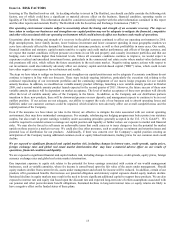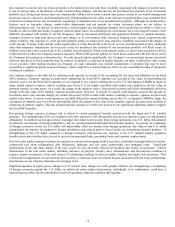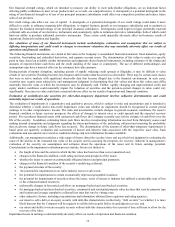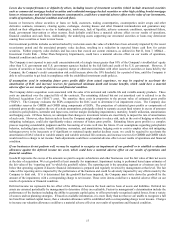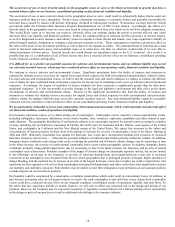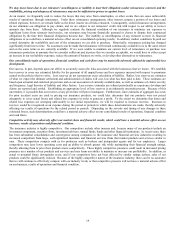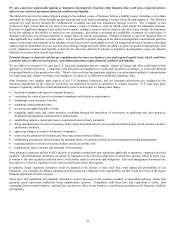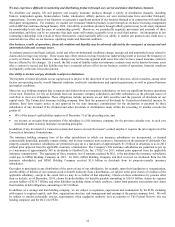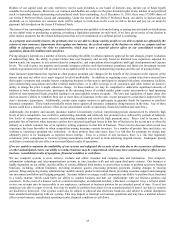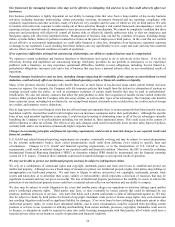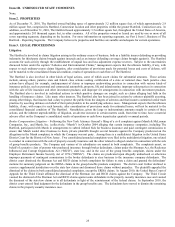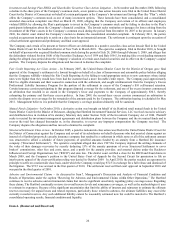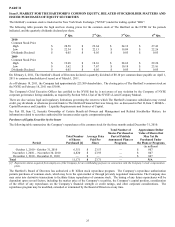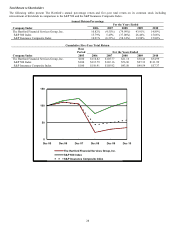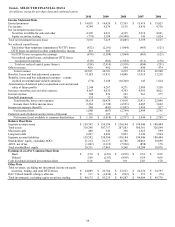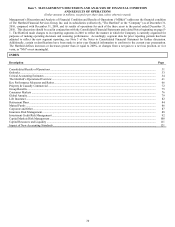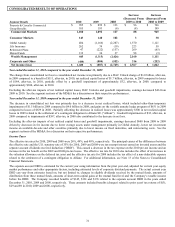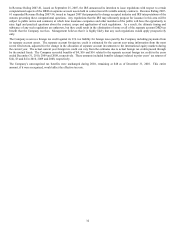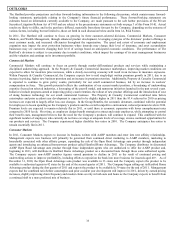The Hartford 2010 Annual Report Download - page 23
Download and view the complete annual report
Please find page 23 of the 2010 The Hartford annual report below. You can navigate through the pages in the report by either clicking on the pages listed below, or by using the keyword search tool below to find specific information within the annual report. 23
Holders of our capital stock are only entitled to receive such dividends as our board of directors may declare out of funds legally
available for such payments. Moreover, our common stockholders are subject to the prior dividend rights of any holders of our preferred
stock or depositary shares representing such preferred stock then outstanding. As of December 31, 2010, there were 575,000 shares of
our Series F Preferred Stock issued and outstanding. Under the terms of the Series F Preferred Stock, our ability to declare and pay
dividends on or repurchase our common stock will be subject to restrictions in the event we fail to declare and pay (or set aside for
payment) full dividends on the Series F Preferred Stock.
The terms of our outstanding junior subordinated debt securities also prohibit us from declaring or paying any dividends or distributions
on our capital stock or purchasing, acquiring, or making a liquidation payment on such stock, if we have given notice of our election to
defer interest payments but the related deferral period has not yet commenced or a deferral period is continuing.
As a property and casualty insurer, the premium rates we are able to charge and the profits we are able to obtain are affected by the
actions of state insurance departments that regulate our business, the cyclical nature of the business in which we compete and our
ability to adequately price the risks we underwrite, which may have a material adverse effect on our consolidated results of
operations, financial condition and cash flows.
Pricing adequacy depends on a number of factors, including the ability to obtain regulatory approval for rate changes, proper evaluation
of underwriting risks, the ability to project future loss cost frequency and severity based on historical loss experience adjusted for
known trends, our response to rate actions taken by competitors, and expectations about regulatory and legal developments and expense
levels. We seek to price our property and casualty insurance policies such that insurance premiums and future net investment income
earned on premiums received will provide for an acceptable profit in excess of underwriting expenses and the cost of paying claims.
State insurance departments that regulate us often propose premium rate changes for the benefit of the consumer at the expense of the
insurer and may not allow us to reach targeted levels of profitability. In addition to regulating rates, certain states have enacted laws
that require a property and casualty insurer conducting business in that state to participate in assigned risk plans, reinsurance facilities,
joint underwriting associations and other residual market plans, or to offer coverage to all consumers and often restrict an insurer’ s
ability to charge the price it might otherwise charge. In these markets, we may be compelled to underwrite significant amounts of
business at lower than desired rates, participate in the operating losses of residual market plans or pay assessments to fund operating
deficits of state-sponsored funds, possibly leading to an unacceptable returns on equity. The laws and regulations of many states also
limit an insurer’ s ability to withdraw from one or more lines of insurance in the state, except pursuant to a plan that is approved by the
state’ s insurance department. Additionally, certain states require insurers to participate in guaranty funds for impaired or insolvent
insurance companies. These funds periodically assess losses against all insurance companies doing business in the state. Any of these
factors could have a material adverse effect on our consolidated results of operations, financial condition and cash flows.
Additionally, the property and casualty insurance market is historically cyclical, experiencing periods characterized by relatively high
levels of price competition, less restrictive underwriting standards and relatively low premium rates, followed by periods of relatively
low levels of competition, more selective underwriting standards and relatively high premium rates. Prices tend to increase for a
particular line of business when insurance carriers have incurred significant losses in that line of business in the recent past or when the
industry as a whole commits less of its capital to writing exposures in that line of business. Prices tend to decrease when recent loss
experience has been favorable or when competition among insurance carriers increases. In a number of product lines and states, we
continue to experience premium rate reductions. In these product lines and states, there is a risk that the premium we charge may
ultimately prove to be inadequate as reported losses emerge. Even in a period of rate increases, there is a risk that regulatory
constraints, price competition or incorrect pricing assumptions could prevent us from achieving targeted returns. Inadequate pricing
could have a material adverse effect on our consolidated results of operations.
If we are unable to maintain the availability of our systems and safeguard the security of our data due to the occurrence of disasters
or other unanticipated events, our ability to conduct business may be compromised, which may have a material adverse effect on our
business, consolidated results of operations, financial condition or cash flows.
We use computer systems to store, retrieve, evaluate and utilize customer and company data and information. Our computer,
information technology and telecommunications systems, in turn, interface with and rely upon third-party systems. Our business is
highly dependent on our ability, and the ability of certain affiliated third parties, to access these systems to perform necessary business
functions, including, without limitation, providing insurance quotes, processing premium payments, making changes to existing
policies, filing and paying claims, administering variable annuity products and mutual funds, providing customer support and managing
our investment portfolios and hedging programs. Systems failures or outages could compromise our ability to perform these functions
in a timely manner, which could harm our ability to conduct business and hurt our relationships with our business partners and
customers. In the event of a disaster such as a natural catastrophe, an industrial accident, a blackout, a computer virus, a terrorist attack
or war, our systems may be inaccessible to our employees, customers or business partners for an extended period of time. Even if our
employees are able to report to work, they may be unable to perform their duties for an extended period of time if our data or systems
are disabled or destroyed. Our systems could also be subject to physical and electronic break-ins, and subject to similar disruptions
from unauthorized tampering with our systems. This may impede or interrupt our business operations and may have a material adverse
effect on our business, consolidated operating results, financial condition or cash flows.


